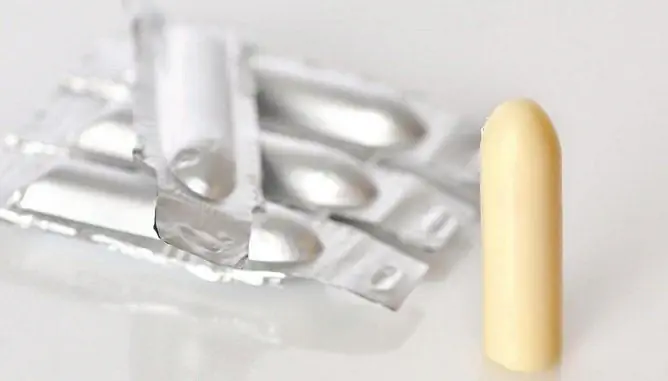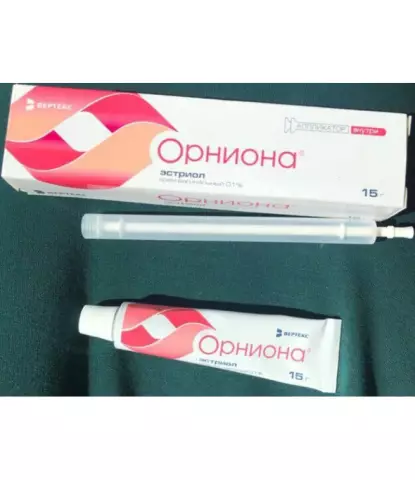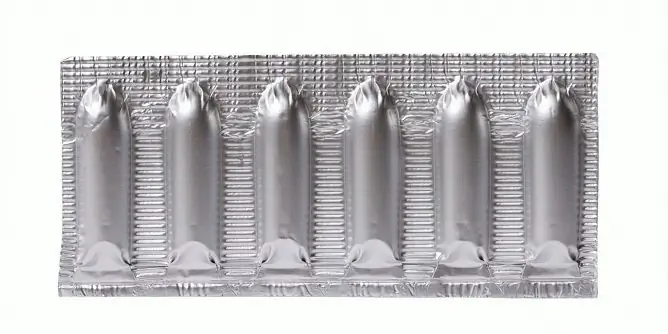- Author Rachel Wainwright [email protected].
- Public 2023-12-15 07:39.
- Last modified 2025-11-02 20:14.
Treatment with suppositories for hemorrhoids during breastfeeding: the main types and characteristics of suppositories for hemorrhoids during lactation
The content of the article:
-
Hemorrhoid suppositories for nursing mothers
- Natalsid
- Procto-Glivenol
- Sea buckthorn oil
- Posterisan
- The main causes and symptoms of hemorrhoids in women during lactation
- Breastfeeding Hemorrhoid Treatment Approach
Suppositories for hemorrhoids during breastfeeding are an effective and affordable treatment, since they have a pronounced local effect, practically not being absorbed into the bloodstream and, therefore, not getting into breast milk. Thus, when using them, the risk of harm to the child is minimal.
For physiological reasons, more than half of pregnant women experience hemorrhoids in one form or another. In most, it appears during pregnancy and passes some time after childbirth, in some women who suffered from hemorrhoids before pregnancy, during this period the disease often worsens. In addition, hemorrhoids can form during childbirth. Thus, the treatment of hemorrhoids during breastfeeding (HB) is an urgent problem of proctology, which is complicated by the fact that many drugs are contraindicated at this time, since they pose a risk to the health of the child.
The popularity of suppositories for hemorrhoids with HB is added by their availability and ease of use. Most of them are inexpensive, their use is not associated with the need for constant visits to the clinic and does not require time-consuming.

Due to their safety, suppositories serve as the main treatment for internal hemorrhoids during lactation.
Hemorrhoid suppositories are available over the counter without a prescription, but although they are safe, they should not be used without first consulting a doctor. The fact is that different drugs have different effects, sometimes the exact opposite (for example, some improve blood circulation, while others prevent bleeding), taking an incorrectly selected drug will not only be useless, but can also worsen the condition.
Hemorrhoid suppositories for nursing mothers
Usually suppositories are used in the presence of internal nodes (internal and mixed forms of hemorrhoids), with external hemorrhoids, the same funds are prescribed in the form of a gel or ointment.
According to the reviews of patients suffering from hemorrhoids and breastfeeding, the most popular suppositories are Natalsid, Procto-Glivenol, Posterisan, as well as sea buckthorn suppositories.
Natalsid
Natalsid rectal suppositories contain sodium alginate obtained from seaweed. It is a safe antiseptic and hemostatic agent. Natalsid eliminates inflammation, bleeding, relieves itching and burning. The drug is approved for use at any stage of pregnancy, as well as during breastfeeding.
Procto-Glivenol
In the composition of suppositories Procto-Glivenol there are two active ingredients: local anesthetic lidocaine and tribenoside, a substance that increases vascular tone, helps to reduce capillary permeability and has anti-inflammatory activity. Suppositories effectively relieve swelling, pain, itching and burning in the rectum. The drug is effective not only in the initial, but also in the later stages of hemorrhoids. May be taken by pregnant women from the fourth month of gestation and by breastfeeding women. In rare cases, the drug can cause a local allergic reaction.
Sea buckthorn oil
Suppositories made from sea buckthorn oil help to eliminate inflammation and enhance regenerative processes in damaged tissues. Suppositories with sea buckthorn are safe and approved for use during pregnancy and breastfeeding, a contraindication is only an individual intolerance to the substances that make up the drug (it can manifest itself as hyperemia, itching, burning in the anal region). The duration of the course and the dose is selected by the doctor, usually sea buckthorn candles for hemorrhoids when feeding a child are recommended to use 1 pc. daily at bedtime for two weeks.

Sea buckthorn oil suppositories can be used to treat hemorrhoids at any stage of pregnancy and during lactation
Posterisan
The action of the Posterisan suppositories is due to the content of E. coli (Escherichia coli) microbial cells in them, killed by phenol, which provoke the activity of leukocytes and antibodies, which helps to relieve inflammation, increase the tone of blood vessels. Suppositories effectively eliminate edema and reduce pain. These suppositories for hemorrhoids during lactation and pregnancy can be used under medical supervision.
Before the introduction of the suppository, you must thoroughly wash your hands, as well as the anal area. After that, you should take the candle out of the package, insert it into the rectum and wash your hands thoroughly again. You should take a horizontal position for about half an hour.
The main causes and symptoms of hemorrhoids in women during lactation
Hemorrhoids are the expansion and deformation of the blood vessels of the rectum with the formation of nodes and the onset of an inflammatory process. Hemorrhoids can be complicated by the development of bleeding from the nodes, their thrombosis, infringement when falling out of the anal canal, etc.
Among the reasons for the development of the pathological process in pregnant women, hormonal changes in the body during this period, the pressure of the growing fetus on nearby organs, an increase in intra-abdominal pressure, and blood stagnation in the small pelvis are distinguished. Also, the disease can occur due to a significant increase in intra-abdominal pressure during childbirth. In addition, hereditary factors, a sedentary lifestyle (including sedentary work), excessive physical activity, unhealthy diet, frequent constipation, wearing tight clothes during pregnancy, etc., can contribute to the development of hemorrhoids.
Hemorrhoids can be internal or external, acute or chronic. In addition, there are 4 main stages in the development of the pathological process (the nodes do not fall out of the anal canal, fall out and adjust on their own, fall out and can be adjusted by hand, fall out and do not adjust).
The main symptoms of hemorrhoids include a feeling of discomfort in the anal area (pain, itching, burning, feeling of a foreign body in the rectum), irritation of the skin around the anus, pain during bowel movements, prolapse of hemorrhoids. Also, a patient with hemorrhoids can detect blood on toilet paper, linen, in feces after bowel movement, etc. In the acute form of the disease, an increase in body temperature may be noted.
Often you can hear the opinion that during breastfeeding, hemorrhoids should not be treated at all, it will go away on its own, and if it does not go away, then it can be cured later. This opinion is wrong. It is better not to postpone treatment, since hemorrhoids do not always go away on their own after childbirth, and the fight against advanced hemorrhoids is much more complicated and may already require surgical intervention.
Breastfeeding Hemorrhoid Treatment Approach
As a rule, with hepatitis B, they are limited to local therapy of hemorrhoids. Effective and at the same time safe drugs in the form of ointments, gel, suppositories are selected. During periods of exacerbation, medicinal sitting baths provide a good therapeutic effect. In addition, lotions and compresses are used. This is usually enough to achieve remission.
Despite the safety of local drugs, during treatment with them, it is necessary to monitor the condition of the child receiving breastfeeding, and at the first signs of any violations (change in behavior, the appearance of skin rashes, etc.), report this to the attending physician. Such cases may be associated with individual hypersensitivity to the drug. An allergic reaction to a drug in a breastfeeding woman requires immediate discontinuation of the drug and replacing it with an analogue with another active substance.
Regardless of the name and degree of popularity, any drugs, as well as traditional medicine for the treatment of hemorrhoids, should be prescribed by a doctor during lactation.
Non-drug methods also play an important and sometimes the main role in the treatment of hemorrhoids. These include remedial gymnastics and diet therapy.
The diet, taking into account lactation, should be balanced in the composition of macro- and micronutrients, and at the same time promote regular and gentle bowel movement. In general, it is built on the observance of the basic rules of a healthy diet. It is necessary to include a sufficient amount of fiber and fermented milk products in the diet, refuse products that contribute to gas formation and constipation, and observe a drinking regime.

The use of any remedies for hemorrhoids during breastfeeding requires consultation with a doctor
Kegel exercises are recommended as therapeutic exercises. In addition to anti-hemorrhoid action, they help to strengthen the pelvic floor muscles, which is especially important in the postpartum period.
Physical overload, especially heavy lifting, should be avoided, and physical activity should be sufficient. The best form of stress for a nursing woman is walking in the fresh air.
YouTube video related to the article:

Anna Aksenova Medical journalist About the author
Education: 2004-2007 "First Kiev Medical College" specialty "Laboratory Diagnostics".
Found a mistake in the text? Select it and press Ctrl + Enter.






